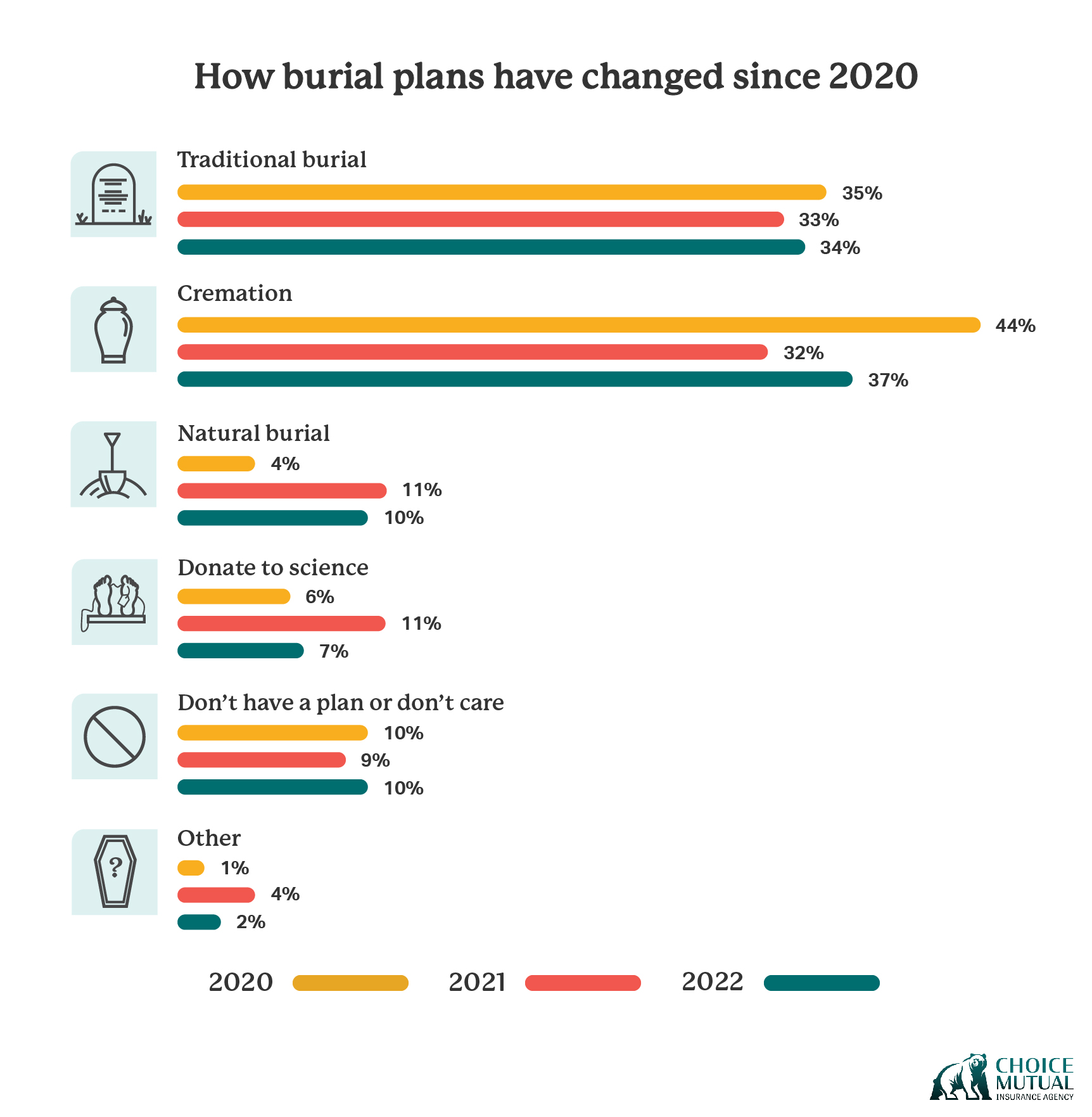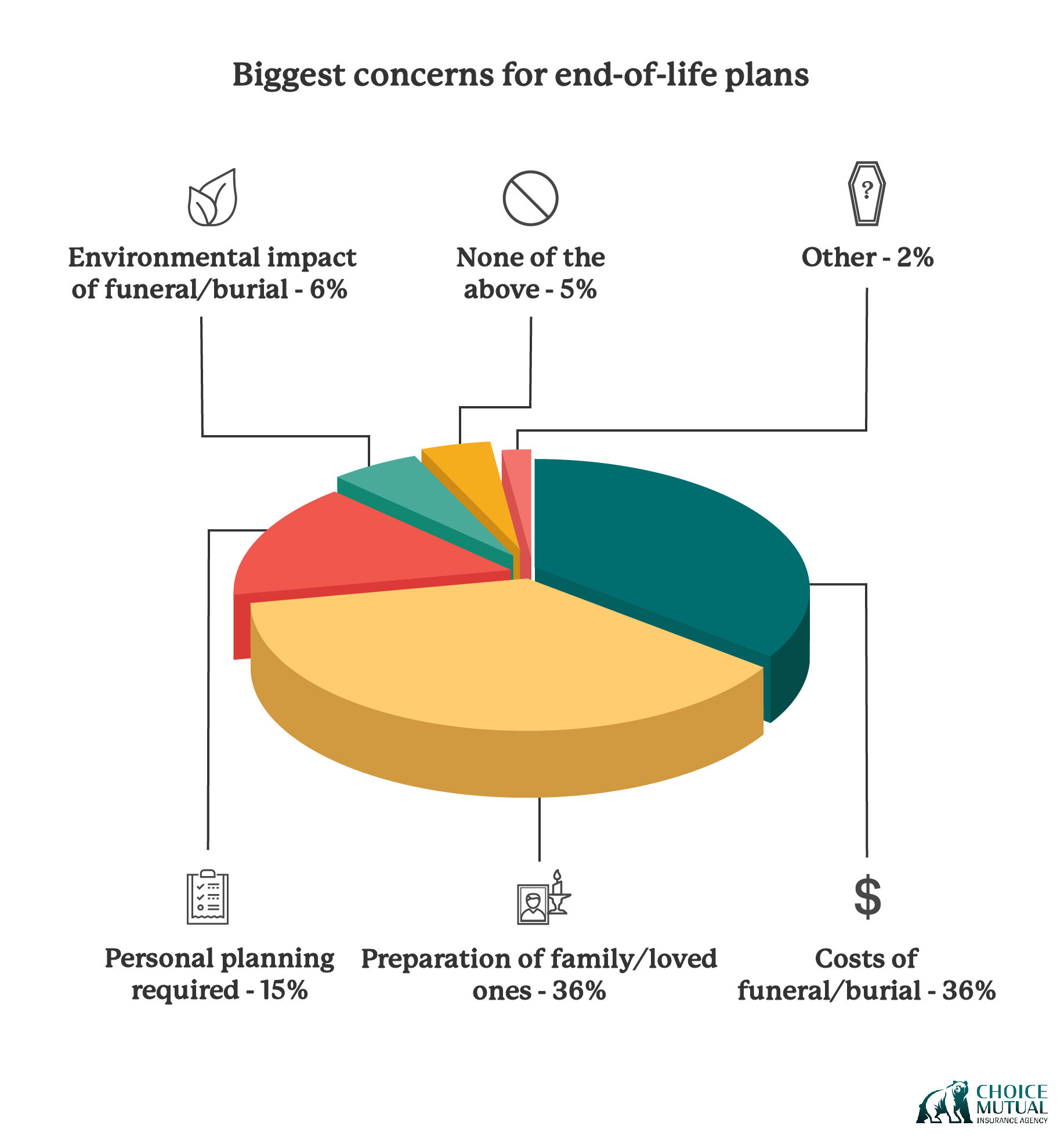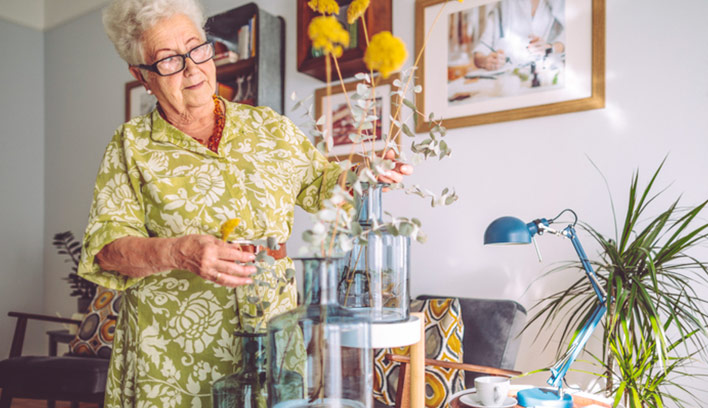This influx of deaths due to the pandemic has prompted Americans to evaluate their end-of-life plans and consider new and alternative burial options.
Now that another year of the pandemic has passed, we conducted a further study in April 2022 of 1,500 people. Our goal was to determine how the country continues moving away from traditional burial preferences toward more modern options.
Burial Preferences In The US: What’s Changed Since 2020
 Since we last surveyed Americans in 2021, the percentage of participants choosing a traditional burial and natural burial has remained relatively consistent.
Since we last surveyed Americans in 2021, the percentage of participants choosing a traditional burial and natural burial has remained relatively consistent.
However, compared to 2020, those choosing a natural burial have increased by 6%. Last year, traditional burial narrowly emerged as the most popular burial selection, closely followed by cremation.
This year, cremation is back to being the top selection (37%), increasing by 5% from 2021 (32%) but still down by 7% compared to 2020 results (44%).
Furthermore, those opting to donate their remains to science have decreased by 4% since 2021, from 11% to only 7%.
A Shift Towards Sustainable Burial Alternatives
Although cremation is the most common funeral method in the United States, the decrease in respondents choosing cremation vs. burial compared to 2020 may be due to the growing availability of more sustainable burial alternatives, including natural burial, alkaline hydrolosis (or aquamation), and body composting.
For context, both cremation and traditional burials cause significant environmental harm.
According to The Baltimore Sun, “Cremation occurs at up to 1,800 degrees Fahrenheit, and one cremation is estimated to use about the same amount of fuel as a car driving 4,800 miles!
This generates considerable carbon emissions contributing to the earth’s warming and releases mercury and other toxins from dental fillings and implanted medical devices.”
In the United States, one of the biggest concerns associated with traditional burials is the fact that it permanently takes up a plot of land.
Many cemeteries in urban areas are running out of space and forcing people who consider location as a factor in their burial plans to make alternative decisions. Forbes reported, for instance, that “Arlington National Cemetery is projected to run out of room by 2041.”
With the issue of limited space aside, traditional burials require extensive use of resources and release significant toxins into the burial ground.
“Over 30 million board feet of hardwoods, 90,000 tons of steel and copper, and 1.6 million tons of reinforced concrete (for vaults) are bought by U.S. consumers and buried in the ground each year.
Also, more than 4 million gallons of toxic embalming fluid goes into bodies and is interred yearly” (The Baltimore Sun).
Natural burial
As the country is becoming more educated on the negative environmental effects of cremation and traditional burials, more people are exploring sustainable alternatives like natural burials.
70% of respondents answered that they are familiar with the natural burial option, also known as a green burial.
By definition, a natural burial is the most simple and widely available sustainable burial process. Instead of being embalmed and put into a casket, the body is placed directly into the ground, where it can naturally decompose. 
Aquamation
Alkaline hydrolysis, also referred to as aquamation, flameless cremation, bio-cremation, green cremation, and water cremation, is an environmentally friendly substitute for cremation and uses water to break down the body.
Similar to cremation, it results in powdered remains that can be kept in an urn or scattered. Aquamation is a lesser-known option than natural burial, with only 36% of respondents answering that they are familiar with it. 
This suggests that the option will become increasingly popular in the coming years.
Body composting
Of the sustainable burial options, body composting is the most recent and difficult to orchestrate. It’s currently only legal in Washington, Colorado, Oregon, and probably soon to be California (Green Matters).
Body composting (or “natural organic reduction”) is a process of body decomposition that generates usable, nutrient-dense soil. Seth Viddal, co-owner of The Natural Funeral in Layfayette, describes the concept in an article from the Associated Press; “It’s a natural process where the body is returned to an elemental level over a short period of time,” said Viddal, who likened the practice to backyard composting of food scraps and yard waste.
“This is the same process but done with a human body inside of a vessel, and in our case, in a controlled environment.” 
Again, there is a significant generational gap that implies the option will grow in popularity as it becomes more universally available.
62% of respondents ages 25–34 would consider body composting compared to only 31% of respondents ages >54.
Why Americans Choose Their Burial Plans

Similar to past years, Americans mostly choose their burial plans for personal reasons (24%), followed by family tradition (23%), and financial reasons (12%).
The percentage of respondents selecting “financial reasons” for why they choose their burial plan has increased by 4% from 2021 (from 8% to 12%).
This may be caused by the significantly increasing cost of burial and funeral expenses in recent years.
End-Of-Life Financial Considerations
69% of Americans responded that they would change their burial plans if money were not a factor.
According to data published by the National Funeral Directors Association, the median cost of a traditional funeral in 2021 in the US was $7,848.
The total cost for a funeral can vary drastically depending on where you live, how your body is disposed of, and any additional memorial options that are selected. The same is true for the cost of a cremation.
19% of respondents said they have personal savings set aside for their funeral. That is a 5% increase from those who set personal savings aside in January 2020 (14%).
In the same vein, those answering that their family will figure it out decreased by 6% from 2020 (23% to 17%). It can be inferred that the harsh reality of the COVID-19 pandemic has inspired more Americans to plan ahead for their end-of-life.
When it comes to planning a funeral, it is important that Americans educate themselves on the costs of each service and compare them across different service providers.
Only half of Americans (49%) are aware of the Funeral Rule, a Federal Trade Commission law that requires funeral homes to provide a General Price List (GPL) to all persons who inquire about funeral arrangements.
The GPL is an itemized list containing the price of every good and service provided by the funeral home. Consumers are given these GPLs to keep and recommended that they be analyzed to calculate the total cost of their planned funeral.
Americans’ End-Of-Life Concerns


Americans ages 18 – 34 showed the most concern for their end-of-life plans, with 59% responding that they are either somewhat worried or very worried. 
The two biggest worries both selected by 36% of respondents are the costs associated with the funeral, and if family/loved ones are prepared for the funeral/burial.
This is followed by the 15% who are most concerned about the personal planning required for a funeral and 6% who are most concerned about the environmental impact of their funeral.
Planning For A Funeral/Burial

One thing that many people don’t consider is what will happen to their digital assets after they have passed. Only 39% of respondents claimed to have a plan for their online accounts to be handled.
In an increasingly digital world, taking the necessary precautions can help your family access the information in your accounts and take any necessary actions.
It is recommended to leave explicit instructions for your will executor to handle your online accounts, including all of the appropriate login information and how to cancel accounts/services.
Do-It-Yourself (DIY) Funeral/Burial
In general, American families are seeking more involvement in their loved ones’ burials and funerals. Elizabeth Fournier, the owner of Cornerstone Funeral Services, shared her insight on this trend, “Active family participation has really been something that has ramped up over this past year.
Families have become very educated [about burials and funerals] during quarantine and read books and watch YouTube. They’ve learned they may conduct tasks commonly performed by a funeral home.
Families are wanting to come into the funeral home and bathe their loved ones, drive them to the cemetery; they’re wanting to bring their loved ones home directly from a hospital or nursing home and have a visitation.”
When surveyed, 54% of respondents said that they would consider a “DIY funeral,” also referred to as “family-directed after-death care,” “community-led care for the dead,” or a “home funeral.”
A DIY funeral empowers loved ones to explore more affordable, meaningful, or eco-friendly memorials for those who have passed. In an interview with KUOW, civil celebrant Holly Pruett said, “Surviving family members who essentially chose to be their own funeral directors found it was more meaningful to have ‘hands-on engagement’ and appreciated having more time with the deceased before saying goodbye.”
In her Washington State home funeral guide, she lists the options available with a DIY funeral:
- Bathing and dressing the deceased
- Sheltering the deceased at home
- Spending time with the deceased (i.e., wake, vigil, or viewing)
- Filing the death certificate
- Obtaining a burial/transit permit
- Making arrangements for final disposition (conventional or natural burial, cremation, alkaline hydrolysis, natural organic reduction)
- Transporting the body home (or to another location) for care and viewing as well as to a place of final disposition
- Making arrangements for any ceremony
Impact Of COVID-19 On American’s Burial Decisions
In June 2021, 37% of Americans responded that their burial plans have changed as a result of the COVID-19 pandemic. However, when surveyed in April 2022, only 24% of Americans responded that their burial plans have changed due to COVID-19.
This downward trend suggests that compared to last year, the country is adapting to the pandemic. With that being said, it is still clear that COVID-19 has impacted Americans’ funeral and burial decisions overall.
Christopher Taktak, aquamation service provider and founder of Pisces, commented on how end-of-life considerations are shifting in the United States, “What is clear is that the pandemic has brought death to the forefront of consumer’s minds. Families experiencing death are much more open to talking about it, planning together, and the pandemic has somewhat forced people to embrace mortality.”
Educating Yourself On Funeral/Burial Options
Americans have more options than ever when it comes to their burial and funeral decisions. Although it can be difficult to think about, it is important to consider your end-of-life plans and educate yourself on the type of funeral you may desire.
Learn more about end-of-life preparation to identify how you want to be remembered and make the process easier for your family and loved ones.
Methodology
We surveyed 1,500 people in the United States about their burial preferences. We asked how they plan on being buried, what influences those plans, which options they are familiar with and would consider, how they are prepared for their end-of-life plans, and how the COVID-19 pandemic impacted their memorial plans.
Here is a detailed overview of the survey participants:
Age:
- 18–24 years: 13%
- 25–34 years: 24%
- 35–44 years: 28%
- 45–54 years: 15%
- >54 years: 20%
Gender:
- Male: 48%
- Female: 52%
Refer to the 2024 survey results for the most up-to-date version of the annual funeral preferences survey.
- Nationally licensed life insurance agent with over 15 years of experience
- Personal annual production that puts him in the top .001% out of all life insurance agents in the nation.
Anthony Martin is a nationally licensed insurance expert with over 15 years of experience and has personally served over 10,000 clients with their life insurance needs. He frequently authors entrepreneurial and life insurance content for Forbes, Inc.com, Newsweek, Kiplinger, and Entreprenuer.com. Anthony has been consulted as an expert life insurance source for dozens of high-profile websites such as Forbes, Bankrate, Reuters, Fox Business, CNBC, Investopedia, Insurance.com, Yahoo Finance, and many more.
Choice Mutual often cites third-party websites to provide context and verification for specific claims made in our work. We only link to authoritative websites that provide accurate information. You can learn more about our editorial standards, which guide our mission of delivering factual and impartial content.
-
According to The Baltimore Sun. https://www.baltimoresun.com/opinion/readers-respond/bs-ed-rr-green-burial-letter-20200117-fmaw4dauhbgn3moqqmwexbfqqm-story.html
-
Forbes reported. https://www.forbes.com/sites/bisnow/2017/11/03/urban-cemeteries-running-out-of-space-as-baby-boomers-enter-twilight-years/?sh=228e0bf1579c
-
The Baltimore Sun. https://www.baltimoresun.com/opinion/readers-respond/bs-ed-rr-green-burial-letter-20200117-fmaw4dauhbgn3moqqmwexbfqqm-story.html
-
Green Matters. https://www.greenmatters.com/p/which-states-allow-human-composting#:~:text=Jay%20Inslee%20legalized%20human%20composting,legalizing%20human%20composting%20in%20Colorado.
-
article from the Associated Press. https://apnews.com/article/technology-lifestyle-religion-environment-and-nature-health-014a5d0bc4f4039181d9863527334ebe
-
Funeral Rule. https://www.ftc.gov/news-events/topics/truth-advertising/funeral-rule
-
Cornerstone Funeral Services. https://www.cornerstonefuneral.com/
-
In an interview with KUOW. https://www.kuow.org/stories/diy-funerals-your-family-can-be-your-own-funeral-director-if-you-want
-
Washington State home funeral guide. https://www.washingtonfuneral.org/






